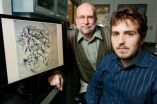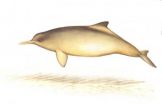(Press-News.org) Red tides and similar blooms can render some seafood unsafe to eat, though it can be difficult to tell whether a particular batch harbors toxins that cause food poisoning.
A new kind of marker developed by chemists at the University of California, San Diego, and reported in the journal ChemComm makes it easier to see if shellfish are filled with toxin-producing organisms.
Mussels and oysters accumulate single-celled marine creatures called dinoflagellates in their digestive systems as they filter seawater for food. Usually dinoflagellates are harmless, but sometimes they produce dangerous toxins. The trick is figuring out when.
Scientists think symbiotic bacteria that live on the surface of dinoflagellates probably help synthesize the toxins, but no one is sure how. Genetic tools often used to sort out such relationships don't work for dinoflagellates, which have enormous genomes that are not well understood.
So chemistry professor Michael Burkhart's group took a different approach. They set up a system to add a fluorescent tag to an enzyme that makes one kind of toxin, okadaic acid, but with a twist. By handing the tag to a the molecule that turns the enzyme on, they ensured that only those parts of cells that are capable of making the toxin would glow.
Specks glow brightly on the surface of dinoflagellates incubated with both the marker and symbiotic bacteria, and the toxin accumulates in the culture. Those lights go off, and toxin production ceases, if the chemists add antibiotics to the mix.
The new marker proved useful in live mussels as well. Their guts glowed with toxin-producing dinoflagellates even before the poison transferred to the mussel tissue itself.
This technique may could be the basis of an early warning system for aquaculturists and in theory it could lower the risk of shellfish poisoning.
Right now, the method requires a relatively expensive fluroscence microscope to view the tagged cells, but Burkhart's team is optimistic that rapidly developing technology will soon make the tag easy to detect with a handheld device.
INFORMATION:
The National Institute of General Medical Science and the American Chemical Society funded this project.
Warning lights mark shellfish that aren't safe to eat
2010-12-16
ELSE PRESS RELEASES FROM THIS DATE:
New method for making tiny catalysts holds promise for air quality
2010-12-16
CHAMPAIGN, Ill. — Fortified with iron: It's not just for breakfast cereal anymore. University of Illinois researchers have demonstrated a simpler method of adding iron to tiny carbon spheres to create catalytic materials that have the potential to remove contaminants from gas or liquid.
Civil and environmental engineering professor Mark Rood, graduate student John Atkinson and their team described their technique in the journal Carbon.
Carbon structures can be a support base for catalysts, such as iron and other metals. Iron is a readily available, low-cost catalyst ...
Researchers discover compound with potent effects on biological clock
2010-12-16
Using an automated screening technique developed by pharmaceutical companies to find new drugs, a team of researchers from UC San Diego and three other research institutions has discovered a molecule with the most potent effects ever seen on the biological clock.
Dubbed by the scientists "longdaysin," for its ability to dramatically slow down the biological clock, the new compound and the application of their screening method to the discovery of other clock-shifting chemicals could pave the way for a host of new drugs to treat severe sleep disorders or quickly reset the ...
Membership in many groups leads to quick recovery from physical challenges
2010-12-16
Los Angeles, CA (December 15, 2010) Being a part of many different social groups can improve mental health and help a person cope with stressful events. It also leads to better physical health, making you more able to withstand—and recover faster from—physical challenges, according to a study in the current Social Psychological and Personality Science (published by SAGE).
Belonging to groups, such as networks of friends, family, clubs and sport teams, improves mental health because groups provide support, help you to feel good about yourself and keep you active. But ...
Concussed high school athletes who receive neuropsychological testing sidelined longer
2010-12-16
Los Angeles, CA (December 15, 2010) When computerized neuropsychological testing is used, high school athletes suffering from a sports-related concussion are less likely to be returned to play within one week of their injury, according to a study in The American Journal of Sports Medicine (published by SAGE). Unfortunately, concussed football players are less likely to have computerized neuropsychological testing than those participating in other sports.
A total of 544 concussions were recorded by the High School Reporting Information Online surveillance system during ...
New study about Arctic sea-ice, greenhouse gases and polar bear habitat
2010-12-16
ANCHORAGE, Alaska – Sea-ice habitats essential to polar bears would likely respond positively should more curbs be placed on global greenhouse gas emissions, according to a new modeling study published today in the journal, Nature.
The study, led by the U.S. Geological Survey, included university and other federal agency scientists. The research broke new ground in the "tipping point" debate in the scientific community by providing evidence that during this century there does not seem to be a tipping point at which sea-ice loss would become irreversible.
The report ...
Meteorite just one piece of an unknown celestial body
2010-12-16
Washington, D.C.—Scientists from all over the world are taking a second, more expansive, look at the car-sized asteroid that exploded over Sudan's Nubian Desert in 2008. Initial research was focused on classifying the meteorite fragments that were collected two to five months after they were strewn across the desert and tracked by NASA's Near Earth Object astronomical network. Now in a series of 20 papers for a special double issue of the journal Meteoritics and Planetary Science, published on December 15, researchers have expanded their work to demonstrate the diversity ...
Where unconscious memories form
2010-12-16
A small area deep in the brain called the perirhinal cortex is critical for forming unconscious conceptual memories, researchers at the UC Davis Center for Mind and Brain have found.
The perirhinal cortex was thought to be involved, like the neighboring hippocampus, in "declarative" or conscious memories, but the new results show that the picture is more complex, said lead author Wei-chun Wang, a graduate student at UC Davis.
The results were published Dec. 9 in the journal Neuron.
We're all familiar with memories that rise from the unconscious mind. Imagine looking ...
New research shows dolphin by-catch includes genetic relatives
2010-12-16
Dolphins along coast of Argentina could experience a significant loss of genetic diversity because some of the animals that accidently die when tangled in fishing nets are related. According to a new genetic analysis published this week in the journal PLoS One, Franciscana dolphins that die as by-catch are more than a collection of random individuals: many are most likely mother-offspring pairs. This result, which suggests reduced genetic diversity and reproductive potential, could have significant implications for the conservation of small marine mammals.
"It has always ...
Polar bears: On thin ice? Extinction can be averted, scientists say
2010-12-16
Polar bears were added to the threatened species list nearly three years ago when their icy habitat showed steady, precipitous decline because of a warming climate.
But it appears the Arctic icons aren't necessarily doomed after all, according to results of a study published in this week's issue of the journal Nature.
The findings indicate that there is no "tipping point" that would result in unstoppable loss of summer sea ice when greenhouse gas-driven warming rises above a certain threshold.
Scientists from several institutions, including the U.S. Geological Survey ...
Vitamin D and parathyroid hormone levels may not affect cardiovascular mortality
2010-12-16
New York, NY, December 15, 2010 – There is burgeoning public interest in possible wide-ranging health benefits from vitamin D, including cardiovascular health. In a study published in the December 2010 issue of The American Journal of Medicine, investigators found that there was no independent association between serum levels of vitamin D or parathyroid hormone and cardiovascular mortality in this prospective study, the first in a population of older community-dwelling adults with a low prevalence of vitamin D deficiency and a broad range of kidney function.
Researchers ...

